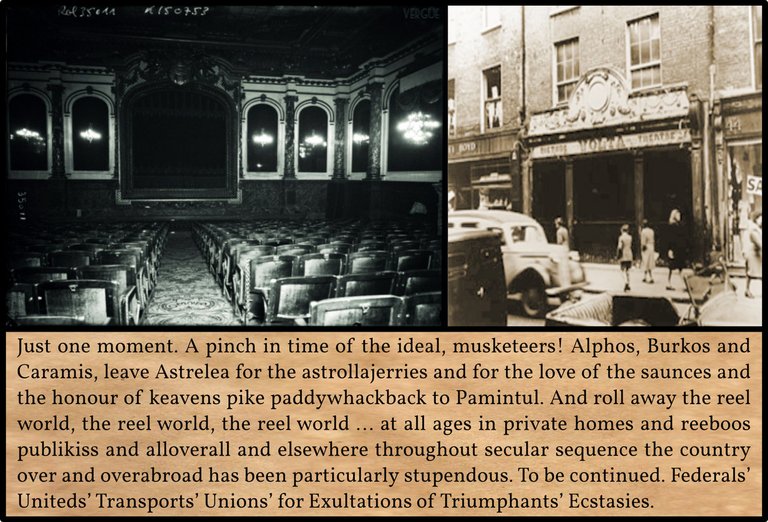
In the next four paragraphs of James Joyce’s Finnegans Wake―three in the original edition―our ongoing investigation into the HCE affair and the Battery at the Gate is interrupted by a visit to the movie theatre. This diversion is bookended by the phrases Just one moment and But resuming inquiries. Not surprisingly, both the main feature and the commercials that precede it share similar plots to HCE’s Original Sin or Crime in the Park.
First-Draft Version
The first draft of this section followed the previous section without a paragraph break, and was in its turn followed without a break by the next section, which describes HCE’s coffin:
Notice a fellow who calls on his skirt. He calls her honeylamb, swears they will be pals, by Sam, and share good times in a happy lovenest when May moon shines but that guy is not so tipsy (not on your life not in these trousers) for somewhere he has girl number two and he would like to canoodle her two for he is downright fond of number one and he is mashed on number two if he cd only canoodle the two and all three would be genuinely happy, the two numbers, namely, and their mutual chappy (for he is simply shamming dippy) if they were afloat in a dreamboat, his tippy canoe, his tippy up and down dippy hiptohippy canoe! So in the present case which bears all the earmarks of a plot. ―Hayman 73
There is nothing of the movie theatre here―the phrase earmarks of a plot suggests rather a radio drama―but by the time Joyce had prepared a new version of this passage for publication in Eugene Jolas & Elliot Paul’s literary journal transition in June 1927 it had acquired some traits that are unmistakeably cinematic:
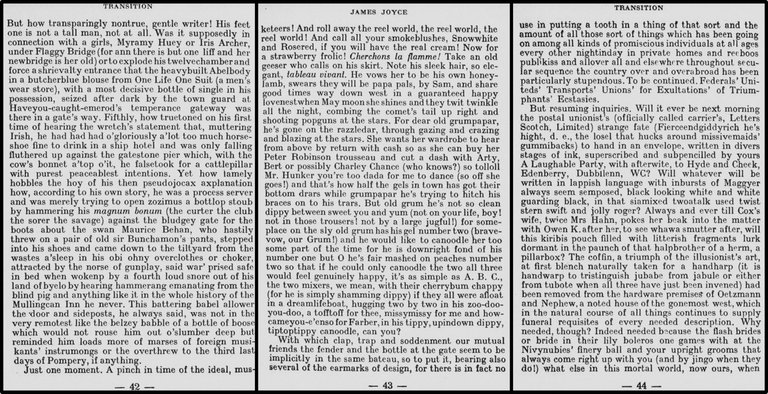
Just one moment. A pinch in time of the ideal, musketeers! And roll away the reel world, the reel world, the reel world! And call all your smokeblushes, Snowwhite and Rosered, if you will have the real cream! Now for a strawberry frolic! Cherchons la flamme! Take an old geeser who calls on his skirt. Note his sleek hair, so elegant, tableau vivant. He vows her to be his own honeylamb, swears they will be papa pals, by Sam, and share good times way down west in a guaranteed happy lovenest when May moon she shines and they twit twinkle all the night, combing the comet’s tail up right and shooting popguns at the stars. For dear old grumpapar, he’s gone on the razzledar, through gazing and crazing and blazing at the stars. She wants her wardrobe to hear from above by return with cash so as she can buy her Peter Robinson trousseau and cut a dash with Arty, Bert or possibly Charley Chance (who knows?) so tolloll Mr. Hunker you’re too dada for me to dance (so off she goes!) and that’s how half the gels in town has got their bottom drars while grumpapar he’s trying to hitch his braces on to his trars. But old grum he’s not so clean dippy between sweet you and yum (not on your life, boy! not in those trousers! not by a large jugful!) for someplace on the sly old grum has his gel number two (bravevow, our Grum!) and he would like to canoodle her too some part of the time for he is downright fond of his number one but O he’s fair mashed on peaches number two so that if he could only canoodle the two all three would feel genuinely happy, it’s as simple as A. B. C., the two mixers, we mean, with their cherrybum chappy (for he is simply shamming dippy) if they all were afloat in a dreamlifeboat, hugging two by two in his zoo-doo-you-doo, a tofftoff for thee, missymissy for me and how-cameyou-e’enso for Farber, in his tippy, upindown dippy, tiptoptippy canoodle, can you?
With which clap, trap and soddenment our mutual friends the fender and the bottle at the gate seem to be implicitly in the same bateau, so to put it, bearing also several of the earmarks of design, for there is in fact no use in putting a tooth in a thing of that sort and the amount of all those sort of things which has been going on among all kinds of promiscious individuals at all ages every other nightinday in private homes and reeboos publikiss and allover all and elsewhere throughout secular sequence the country over and overabroad has been particularly stupendous. To be continued. Federals’ Uniteds’ Transports’ Unions’ for Exultations’ of Triumphants’ Ecstasies. ―Jolas & Paul 42–44
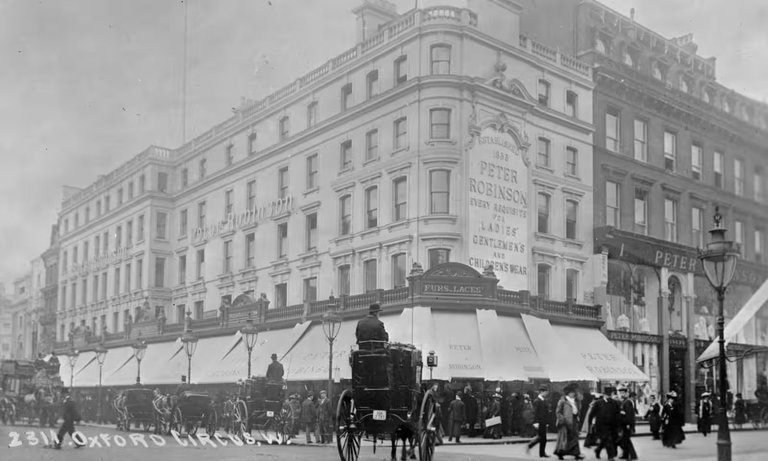
The story of the old geezer (chap = HCE) and his skirt (girlfriend = Issy) is now preceded by a few lines that will in time become two separate paragraphs. The first of these is best interpreted as taking place outside the cinema, while the second represents the commercials that are shown before the main feature. In the paragraph that follows the main feature we are told that the story is To be continued, a phrase that was frequently used in cinemas―and the print media―after episodes of a serial story.
By 1939, when the first edition of Finnegans Wake was published, this passage had been expanded into a sequence of three paragraphs. In The Restored Finnegans Wake of 2010 Rose & O’Hanlon inserted another paragraph break at Take an old geeser who calls on his skirt, resulting in four paragraphs. In this version the main feature is preceded by two short introductory paragraphs and followed by one short concluding paragraph. None of these was present in the first draft.
When they wrote A Skeleton Key to Finnegans Wake Joseph Campbell & Henry Morton Robinson were already aware that this passage was to be read as a visit to the movie theatre:
[At which point, suddenly, the American sugar-daddy digression:] Let us turn our eyes to the reel world. Come on, you boys and girls, settle back for a strawberry frolic! First appear the ads. (65 [RFW 052.11]) Then comes the following popular feature: Take an old geeser who calls on his skirt ... ―Campbell & Robinson 74
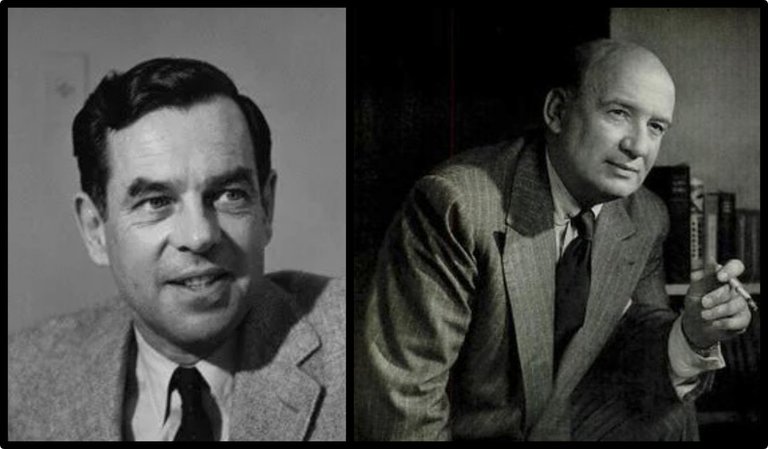
James Atherton also discerned the presence of cinematic terms in this passage:
This trope of the literary creation of a world is best seen in Joyce’s treatment of films, a topic which has been surprisingly ignored in spite of such hints as ‛roll away the reel world, the reel world, the reel world’ (64.25 [RFW 052.01]).
The two preliminary paragraphs have been coloured by the HCE affair, as have the main feature and the epilogue.
Just One Moment
This short paragraph seems to take place as the roll of film is being readied. The real world is going to be replaced by the reel world. In the three musketeers, Athos, Porthos and Aramis, we can see Shem, Shaun and the Oedipal Figure. We also have Kevin & Jerry (Shaun & Shem), and the two Issy’s, Snowwhite and Rosered―cream is white, while strawberries are red. Kevin, as usual, is associated with Heaven (Keavens) and Jerry with Hell (Astrelea)―in Finnegans Wake Australia, or Down Under, often stands in for the Underworld.
The first draft of this paragraph was much shorter than the final version:
Just one moment! A little pinch in time of the ideal, gentlemen musketeers. (James Joyce Digital Archive)
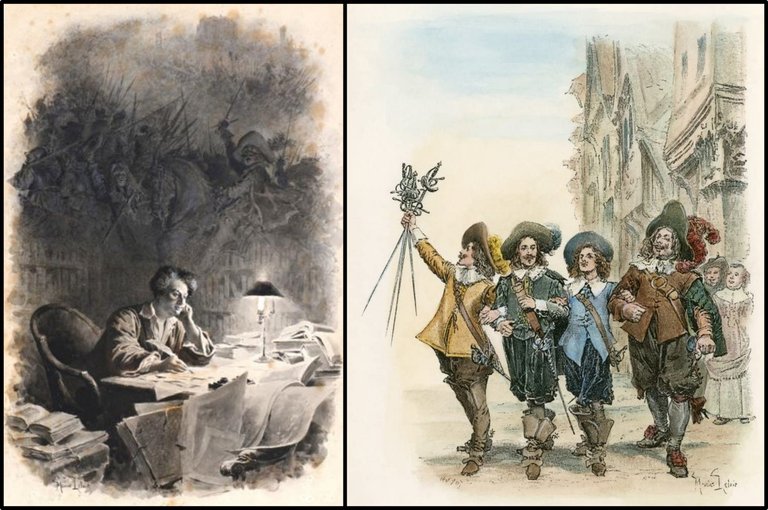
Several details of the final version anticipate the main feature, so perhaps this paragraph also represents a poster advertising the movie outside the cinema.
We had to pay to get into the Museyroom (the Paddy Patkinses, one shelenk), so it is only right that we be charged an entrance fee to enter the movie theatre:
French: filons, let us hand over. The usual meaning of filons is let’s get out of here! But Rose & O’Hanlon’s removal of the comma after filons supports my interpretation.
World War I Slang: filoosh, money. This is the tenth time Joyce has turned to Walter Hubert Downing’s Digger Dialects: A Collection of Slang Phrases Used by the Australian Soldiers on Active Service. Filoosh is identified by Digger as Arabic, which probably means that it comes from the Egyptian Arabic: فلوس [filūs], money (Downing 23). Below are several more borrowings from Downing:
- chatbags (underclothing)
- lump of lead (head)
- sweatyfunnyadams [Sweet Fanny Adams] (nothing, vacuity)
- Creampuffs (A shell-burst)
- Every nice, missymackenzies [Very nice, very sweet, very clean, very good, Mister Mackenzie] (A street phrase of the Egyptian hawkers and shopkeepers, in extolling their wares to an Australian). Miss Mackenzie is the eponymous character in a novel by Anthony Trollope, who worked for the postal service in Ireland and introduced the pillar box to the British Postal Service in 1852. In the 1865 novel Miss Mackenzie has to choose between three suitors for her hand. These postal associations will be taken up on the next page.
- Furphy (A rumour)
- Compree (Understand). French: compris, understood.
- chivoo (A celebration)
- Finny (Finish). French: finis, finished (plural).
- Ack, ack, ack (Full stop. Three A’s in a field telephone message signify the end of a sentence. Otherwise expressed as “three to a loaf,” “three of a kind,” etc.)
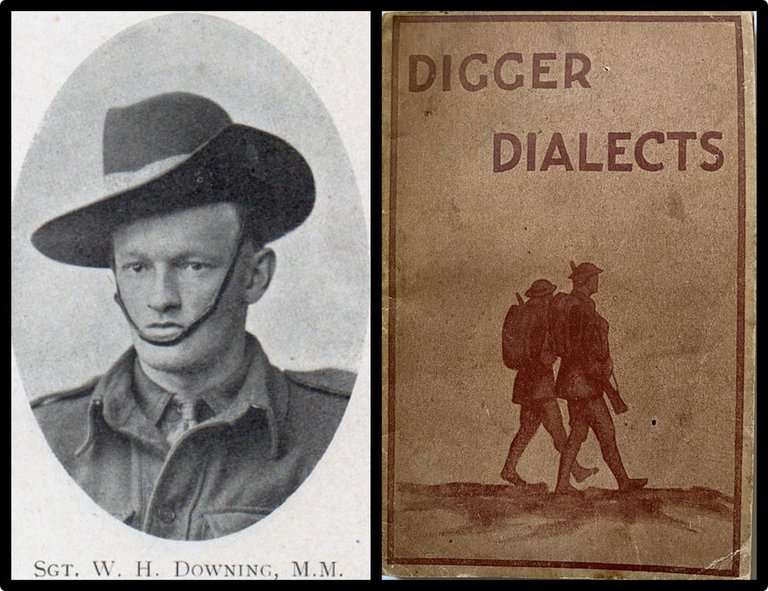
The presence of World War I slang used by Australian troops (Diggers) suggests that the three musketeers are soldiers from Down Under. This would explain why they are told to leave Australia for the astrologer Jerry:
This allegiance of Shem’s to the underworld of Australia is repeatedly established. He is not only an occult ‛alshemist’ but also a fraudulent astrologer. At 64.23 [RFW 051.39] the three musketeers are advised to ‛leave Australia to Jerry the Astrologer’―partly, perhaps, because there are rather more visible stars in the southern hemisphere. ―Hart 119
Finally, the projector’s bright lamp is illuminated:
Cherchons la flamme!
Commercials
Before the main feature we have some commercials. Weight loss and a cure for baldness are advertised―relevant, as HCE is certainly corpulent and losing his hair (RFW 041.21–22). There may also be an advertisement for a popular drink―a root beer made with bruised (ie crushed) ginger―and one for a muscle-building course. Joyce was inspired here by some issues of the popular magazine Picture Play, which was devoted to the movie industry (see MacArthur & Braslasu for details):
- Noah Beery Noah Beery, Senior was a prolific star of early cinema. He is mentioned in the February 1931 issue of Picture Play. Joyce must have loved the accidental allusion to the Biblical Noah, who cultivated the vine and got drunk on his own beer (Genesis 9:20–27): a dreamlifeboat, hugging two by two in his zoo-doo-you-doo and in the same bateau.

- fat’s falling fast ... why not yours? From an advertisement in Picture Play:
No need to tell you fat is going fast. Think back ten years ago. Most folks above 40 were over-fat. Now slender figures are everywhere the vogue ... MARMOLA Prescription Tablets / The Right Way to Reduce ―Picture Play Magazine, January 1931, Page 111
- Blossomtime’s Sigmund Romberg’s operetta Blossom Time is mentioned in the January 1931 issue of Picture Play.
There are also advertisements for Charles Atlas’s muscle-building course.
Take an Old Geeser
The main feature is patently yet another retelling of HCE’s Crime in the Park, with the familiar love triangles.
- Finny In addition to the borrowing from Downing’s Digger Dialects we have here an allusion to FIN, the French word meaning The End that appeared at the end of many early movies.
After the Performance
Ack, ack, ack. Besides the borrowing from Downing’s Digger Dialects this represents the flapping sound made by the end of the roll of film as it spins in the projector.
clap, trap and soddenment Characteristics of the three Viconian Ages: thunder, marriage and burial. Also, clap represents the applause of the audience in the movie theatre.
To be continued In addition to the use of this phrase at the end of an installment of a popular cliffhanger in both the print media and on the silver screen, Joyce probably has the 1001 Nights in mind. In the frame story of this collection of folktales Scheherazade’s narration is repeatedly interrupted at dawn on a cliffhanger:
Hence the Persian proverb, “Báki-e-dastán fardá” (the rest of the tale tomorrow), said to askers of silly questions. ―Richard Francis Burton 145 fn 2
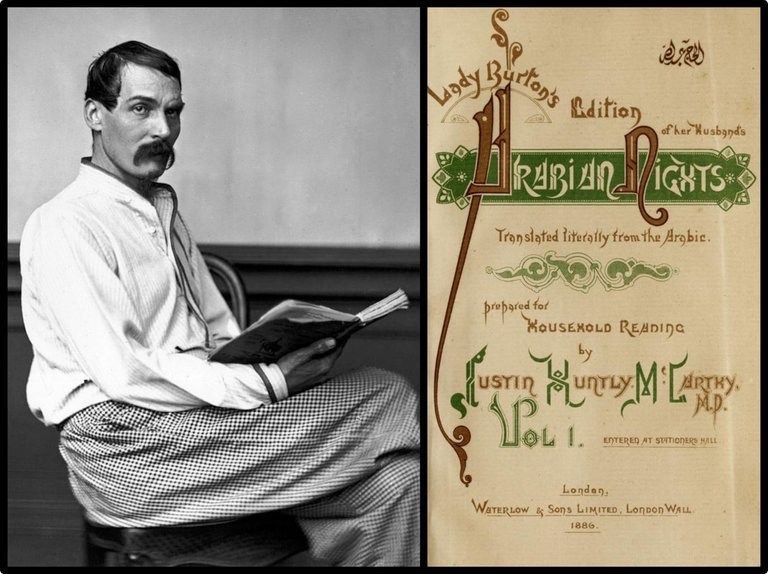
- Federals’ Uniteds’ Transports’ Unions’ for Exultations’ of Triumphants’ Ecstasies An acrostic for Latin: futue te! fuck yourself!.
Joyce and Cinema
It is now a well known fact that James Joyce opened Ireland’s first cinema. This was one of the commercial ventures he undertook shortly after he left the country―before the publication of Ulysses made him famous and won for him the patronage of a wealthy and generous woman.
It was not until 1909 that Ireland’s first permanent cinema, the Volta, opened. The idea for the cinema originated in Trieste when James Joyce’s sister, Eva, commented that Dublin, a city larger than Trieste, had no cinema. James Joyce took up the idea with four local businessmen including exhibitors with cinema interests in Trieste and Bucharest. They agreed to put up the necessary capital while Joyce would organise the venture in return for a 10 per cent share of the profits. Joyce arrived in Dublin on 21 October 1909 and set about acquiring premises. This he did a week later when he located 45 Mary St, near Dublin’s main thoroughfare, Sackville St. He then proceeded to convert the premises into a cinema. Two of his Italian partners arrived a few weeks later and went with Joyce to both Belfast and Cork in search of further premises. Another partner and the cinema's manager, Novak, arrived from Italy in early December accompanied by an Italian projectionist.

For the opening of the Volta Cinema on 20 December 1909 Joyce chose a varied programme. Devilled Crab was a comedy while Bewitched Castle was ‛a magnificent fantastic picture’ according to the Dublin Evening Mail. Other films in the 35–40 minute programme were The First Paris Orphanage, La Pourponniere and a story of patricide, The Tragic Story of Beatrice Cenci (1908)’ which The Freeman’s Journal described as ‛very excellent’ but complained that it
was hardly as exhilarating a subject as one would desire on the eve of the festive season. But it was very much appreciated and applauded.
The Dublin Evening Mail had also found the films ‛very praiseworthy’ and the Volta ‛a fine hall’.
Despite the favourable notices for the new venture poor weather gave the cinema a slow start. Joyce did succeed in obtaining a permanent licence for the cinema from the Recorder but by this time his enthusiasm had begun to wane. He left Dublin for Trieste with his sister, Eileen, on 2 January leaving the management of the Volta in the hands of Novak. ―Rockett, Gibbons & Hill 5–6
Novak failed to make a go of it and he sold the Volta to an English firm, the Provincial Theatre Company, in July 1910, under whose management it became moderately profitable. Joyce received nothing from the sale. The theatre closed down in 1919, but two years later it reopened as the Lyceum Pictures Theatre. It closed its doors for good in 1948. The site was bought by the Irish retailer Penneys, who opened their first department store next door in 1969, almost exactly sixty years after the Volta first opened its doors. Ireland’s first cinema was subsequently demolished to make way for an extension to the department store. The site is now marked by a small plaque.
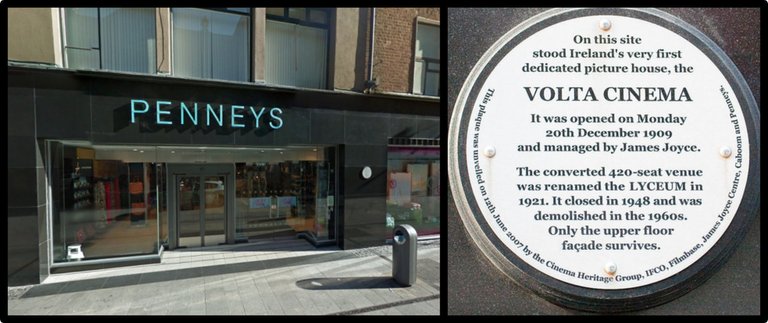
And that’s as good a place as any to beach the bark of our tale.
References
- Richard Francis Burton, Book Of The Thousand Nights And A Night: A Plain and Literal Translation of the Arabian Nights Entertainments, Volume 10, The Burton Club, London (1886)
- Joseph Campbell, Henry Morton Robinson, A Skeleton Key to Finnegans Wake, Harcourt, Brace and Company, New York (1944)
- Walter Hubert Downing, Digger Dialects: A Collection of Slang Phrases Used by the Australian Soldiers on Active Service, Lothian Book Publishing Co, Melbourne and Sydney (1919)
- David Hayman, A First-Draft Version of Finnegans Wake, University of Texas Press, Austin, Texas (1963)
- Eugene Jolas & Elliot Paul (editors), transition, Number 3, Shakespeare & Co, Paris (1927)
- James Joyce, Finnegans Wake, The Viking Press, New York (1958, 1966)
- James Joyce, James Joyce: The Complete Works, Pynch (editor), Online (2013)
- Ian MacArthur & Viviana-Mirela Braslasu, Gleanings from America in VI.B.1. VI.B.8, VI.B.19 and VI.B.31, Genetic Joyce Studies, Issue 19, Centre for Manuscript Genetics, University of Antwerp, Antwerp (2019)
- Danis Rose, John O’Hanlon, The Restored Finnegans Wake, Penguin Classics, London (2012)
- Street & Smith (publishers), Picture Play, Volume 33, Number 5, New York (1931)
Image Credits
- Omnia Pathé Cinema, Paris: Léon & Lévy (photographers), Public Domain
- Volta Picture Theatre, Dublin: Anonymous Photograph, Liam O’Leary Archive, Public Domain
- Peter Robinson Department Store (Oxford Street): Daily Chronicle, Mary Evans Picture Library, Public Domain
- Joseph Campbell: © UCLA Libraries, Fair Use
- Henry Morton Robinson: © P Ballantine and Sons Brewing Company, Newark, New Jersey, Fair Use
- Alexandre Dumas: Alexandre Dumas Writing The Three Musketeers, Maurice Leloir (artist), Calmann-Lévy, Paris (1894), Public Domain
- The Three Musketeers: D’Artagnan & the Three Musketeers, Maurice Leloir, Calmann-Lévy, Paris (1894), Public Domain
- W H Downing: The Scotch College, Melbourne, Public Domain
- Digger Dialects: Blackheath Rare and Collectible Books, Digger Dialects, First Edition, Lothian Publishing Company, Melbourne (1919), Public Domain
- Noah Beery, Sr: University of Washington, J Willis Sayre Collection of Theatrical Photographs, Public Domain
- Richard Francis Burton: Anonymous Photograph, Rischgitz Collection, Hulton Archive, Public Domain
- Arabian Nights: Frontispiece of Lady Burton’s Edition of Her Husband’s Arabian Nights Translated Literally from the Arabic, Waterlow & Sons, Limited, London (1886), Public Domain
- The Volta Shortly Before Its Demolition: Anonymous Photograph, Public Domain
- Penneys: © Google Maps, Fair Use
- Volta Commemorative Plaque: © Cinema Heritage Group, Fair Use
Useful Resources

Congratulations @harlotscurse! You received a personal badge!
You can view your badges on your board and compare yourself to others in the Ranking
Check out our last posts: